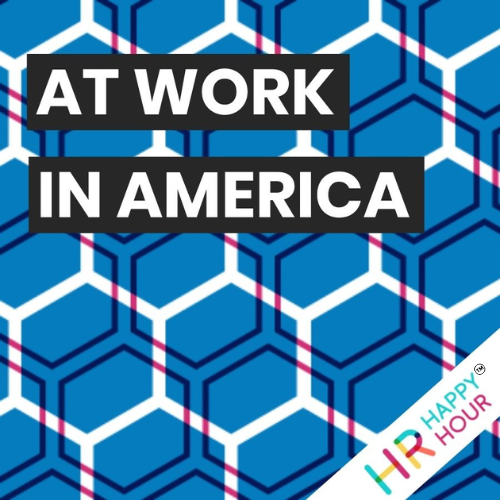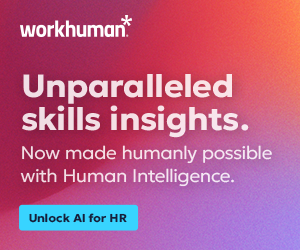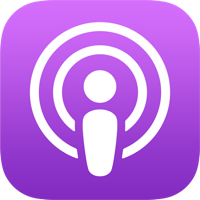Empathy and Expertise: Insights on Layoffs and Inclusion
Hosted by

Mervyn Dinnen
Analyst, Author, Commentator & Influencer

Trish Steed
Co- Founder and Chief Strategy Officer, H3 HR Advisors
About this episode
Empathy and Expertise: Insights on Layoffs and Inclusion
Hosts: Trish Steed, Mervyn Dinnen
Guest: John Baldino, President of Humareso
This episode of At Work in America is sponsored by Paychex, one of the leading providers of HR, payroll, retirement, and insurance solutions for businesses of all sizes. Visit paychex.com/awia today.
This week on At Work in America, Trish and co-host Mervyn were joined by John Baldino to talk about HR consulting and the importance of handling layoffs well.
– Introduction to HR consulting
– How to properly handle layoffs, starting with the uncomfortable conversation
– The humanity side of the layoff process
– The difference between diversity and inclusion
This was a really interesting show, thanks to John for joining us! Remember to subscribe to the HR Happy Hour Network wherever you get your podcasts.
Transcript follows:
Announcer 0:00
Welcome to At Work in America, sponsored by Paychex. At Work in America digs in behind the headlines and trends to the stories of real people making a difference in the world of work. And now here are your hosts, Steve Boese and Trish Steed.
Trish 0:25
Hi, and welcome to At Work in America. I’m Trish steed and we have a really exciting show for you today. First and foremost, though, I have one of my favorite guest co-hosts with me, Mr. Mervyn Dinnen, host of the HR Means Business podcast. Welcome, Mervyn. How are you?
Mervyn Dinnen 0:43
Hi, Trish. It’s a pleasure to be here. No, I’m doing good. I’m doing good. I’m coming to you live from London where it’s been a sunny day. And it’s been a good day. I’m in a good, a good place. I’m looking forward to this chat tonight.
Trish 0:56
I love that. And you know what, I love that you’re bringing sort of that that whole not just UK perspective, the whole European perspective to the conversation, right? You hear completely different news than what we get over here in the States. And I think these episodes are always fun because we we touch on things in a very different way, I think than when Steve and I do it. So I’m excited to have you here.
Mervyn Dinnen 1:18
Thank you. I’m excited to be here.
Trish 1:20
Good. Well, before we get started, we have a really awesome guest, I have to tell you, whenever the three of us get together, it’s like a laugh fest, right, we all just crack each other up the whole time. So hopefully, we’ll have some more laughs that come out of the next 30 minutes or so. But also we’re going to cover some really serious topics too. But before we do, I want to say thank you to our sponsor, our friends at Paychex. Paychex, who is one of the leading providers of HR, payroll, retirement and insurance solutions for businesses of all sizes. After years of being in survival mode amidst a global pandemic HR leaders have been challenged to get back to business ushering in the era of the dynamic workplace. In our seventh annual Pulse of HR Report, find out how these leaders are optimizing the work experience, regardless of where it’s done, addressing widening generational gaps and increasing productivity, not just for the employees, but also for themselves. You can learn more by visiting paychex.com/awia and check it out today. So thank you to our friends at Paychex.
Trish 2:29
Now, I would love to welcome John Baldino. John actually joined us on a remote show which was very short clip and so we wanted to bring John back to talk for a little bit longer about what he does. For 30 years he has been working in human resources and his passion of setting contributions and companies up for success is still going strong. John is a keynote for US and international conferences where he shares content and thoughts on leadership, collaboration and innovation, employee success, org design and development as well as inclusion and diversity. He is the winner of both the Greater Philadelphia HR person and consultant of the Year award. Oh, I didn’t know that. And also the co host of the wildly popular LinkedIn live webcast, But First Coffee. John is currently the President of Humareso, a global human resource consulting firm and the proud dad of three amazing young adults. John, welcome to the show.
John Baldino 3:35
Hello, good to see you Trish and Mervyn, thanks for having me.
Trish 3:39
Yes, and congratulations on those awards. I was not aware how did I miss that?
John Baldino 3:45
You know, there’s too much stuff online.
Trish 3:49
You know what, before I know we’ve got a ton that we’re going to cover today and just something I just read that I do want to at least point people in the direction of can you just talk for just a minute before we get into humor so in the in the larger kind of job you do but your new webcast? But First Coffee, am I right? This has only been like a short few episodes right? I’ve seen it pop up.
John Baldino 4:09
It’s been so, Jackie Clayton and I do it and and those that know Jackie out of Texas. And so now I would say it’s been about a year already. Yeah, I mean, it has gone by so quickly. We do it on Thursdays at 10am Eastern Time and it’s really we sort of call it the live with you know Kelly and Mark for HR. Yeah, it’s super fun, and probably mildly inappropriate, but it’s wonderful.
Trish 4:45
Oh good. Well, listen, obviously we read the official bio. Why I would love if we could maybe just kick off before we dive into the topic side of things. Maybe just tell us a little bit about Humareso, what you’re working on, and what kind of clients you have kind of all the dirt, if you would?
John Baldino 5:05
Sure. So we are coming up on 11 years, at Humareso on August 1, which is so fun, and I’ve had the privilege of putting that together and working now with some amazing people. And so from an HR consulting firm standpoint, we’re supporting primarily US organizations, some, some international, but mostly US based, and really doing so in a few different ways, whether it be, you know, project based consultative, and HR strategy, perspective, um, but also blocking and tackling. You know, and I’m sure some of the things that we’ll talk about, but there are some organizations that are really struggling with basic admin basic compliance around HR work. And so we’re able to step in and that capacity as well and kind of sit even for some companies on the startup, I’d say to small business standpoint on that HR row, kind of capacity. And that’s been amazing as well, until we’ve done that for all these years and grown a bunch.
Trish 6:12
Well, wonderful. I know it’s such a privilege, actually, when you can have a consultant come in when you’re sitting in that HRC. Sometimes it’s, it’s valuable. You might even know what you want to do. But it’s having that external voice validate the direction you’re trying to take or bringing those super creative ideas to you. Right, I’m sure you see both.
John Baldino 6:34
Yeah, absolutely. And I will tell you the one other thing, and it’s funny, because it came up this morning, funny enough, is sometimes the fear that HR people have when we sit when you might think I don’t know how to do something, or the best way to do something. And I’m hesitant to ask because someone may think I don’t know how to do my job, or someone, maybe even my CEO might think I don’t know how to do my job. And so having a consultants come in, would really make me look bad. And really, just like you said, Really, it’s quite the opposite. We want to make that HR practitioner look like a hero, and really be able to set them up for success and have them win in the ways they need to win. I tried to tell businesses all the time, who are worried about something like that, I don’t want your job, really keep your job. It’s not what I’m after. I’m excited to see you be set up for success. So that’s what our entire team is here to do. So. Yeah, I think that you’re right in that having someone to bounce those ideas off of to say, what do you think even if it’s an hour conversation, what do you think? I think that’s pretty.
Trish 7:48
Yeah, really helpful. Yeah. Mervyn, have you ever used consultants in your long and illustrious career?
Mervyn Dinnen 7:57
Long? Yeah, I don’t know, the illustrious of I have, I suppose in years gone by, I had my own kind of recruiting business, then I didn’t need kind of external help. But I’ve kind of, I suppose for the listeners to this show, and stuff, you know, would know me over the last 10-12 years where I’ve pretty much been an independent. So I get asked questions a lot. And I do I do take inspiration from others. But I haven’t had to bring bring in a consultant. And I suppose if thinking back to the time, when I did, it was always helpful. I was always conscious of the fact that if the advice I was getting was was different to what I thought it should be, that I needed to challenge that and to try and understand it myself. But no, I mean, I would never, you know, I’m always very happy to turn to other people who I feel, you know, either know, more than me or in a better or have a better perspective on something that may, or even just to bounce ideas off and say, Listen, I’m not 100% sure what I’m doing with this. So, you know, co authoring a book, say, as I’ve done with Matt, a couple of times, Matt Alder. Yeah, you often have to kind of go to each other and say, the sound bit stuck here. You know, what would you do with it? What? And speak to third parties as well, I know that I’ve had a couple of sessions with people writing books who’ve said to me, you know, what, what, what do you do when you get stuck at this or that? So it’s, it’s always helpful, it’s always helpful to have somebody else to, to, if nothing else, bounce ideas off or talk to or get a different perspective.
Trish 9:45
Yeah, I agree. I think, you know, you hit on a couple things there. And some of the things we actually want to speak with John about today, which is really, you know, as you’re going through some of just that Johnny mentioned blocking and tackling, right, those are those are Some of those important activities and, and we’ve got a few that are maybe a little more strategic, but one I would love to just kick off with because as I mentioned sort of pre show, we haven’t really covered this in a very, very long time around how to properly lay people off. Unfortunately, this is something that we all as human report, human resource professionals have to do in our career. And sometimes we’re better at it than others. And unfortunately, with the economy the way it is right now, in different pockets, you know, the certain pockets are hiring, like crazy, and certain pockets are laying off. And so I’d love to maybe just hear your perspective on something is, I guess, that we don’t think much about, right. We just think, Oh, I’ve just got to go have that conversation and what do you do? And how do you approach that differently when you’re working with your clients?
John Baldino 10:53
Yeah. It’s a great question, honestly, because it is, it’s such an undesired thought, right? So you try not to think about the things that are going to make you feel achy or, you know, be in a tough situation. I think that’s the first step, quite frankly, for a practitioner is just to own the fact that it’s going to be uncomfortable and awkward, just just owning, sit in it for a minute. It’s never, you know, exciting to sit with someone and say I’m so sorry, we can’t move forward with you, especially when it may have should have nothing to do with the quality of performance of the person, it really is a say a financial decision, we are just down in our revenue or our sales pipeline is drying up at the moment, or people are putting work on hold even that they’ve agreed to, but because they’re going through, and you can see this in consulting, of course, because of what their industry is going through, they may have to pause on some of the consultative work that they were seeking, because they’re just trying to pull budget in. And that’s when I think you need to just sit in that honesty, with the employee that you’re speaking with to say, here’s what’s going on, right, as you’ve seen, and hopefully your organization has operated with a decent portion of transparency, that they see a slowdown perhaps in some projects, or that they’ve seen a slowdown in again, if you’re in house and manufacturing or distribution or technology, those areas where it’s very, it shouldn’t be very easy to see a cadence of work, then I think it’s easier to sit with someone to say you probably have noticed, right? We’re we’re down a bit. And we’ve got to make some cuts as a result of it. I think it’s so important to not over promise as well, in these layoff moments, right? If there’s anything I can do for you, please let me know that’s not true. That’s Don’t say things that aren’t true, right. But you don’t really mean if there’s anything I can do for you what you want to be as specific. If you when you’re ready after this, right, if you want me to kind of take a peek at your resume that you’re going to be using to send out I’d be happy to do that.
John Baldino 13:09
Or if you know if there’s any particular roles that you find online that you see I might be connected to through LinkedIn or this or that, please pick my brain. I can’t say that I’m close with every you know, contact, but it least asked me and I’m happy to see what I can do. And speak specifically into that person. Of course, from a tactical standpoint, you want to have your ducks in a row in terms of you know, is today the last day is at the end of the week, what will happen with benefits? What do I do with equipment, really the the things you would do with any separation, and make sure that that person knows? And has the answers to anything that they may be thinking of, not only in that moment, which may have caught them unawares, but how to have a door that’s open tomorrow? How about if you know you go home, but if you think of things tomorrow that we didn’t cover today, I’m free at 10 o’clock? How about if I block a half an hour from 10 to 1030? Call me. If you have anything I’m happy to, you know, chat with you answer anything else that that may have kind of crept into your head in the middle of the night, and want to make sure that you feel like you’ve gotten all the answers you need. Be gracious, honestly, and I know it’s hard and awkward to do this, but don’t forget who you are. Right? We’re in the business of the full employee experience. And that actually even includes separation, even when you’re laying or terminating someone for cause. You know, we shouldn’t get joy out of terminating someone for cause we ought to sit and be pained just as much as we might be as as if it’s a layoff because it’s going to leave a gap. We’re going to have to cover work for someone that’s no longer going to be there and we can’t fill that role. We’re all going to have to sort of split that work up amongst other people. So There’s a lift all the way around. And I’ll just also add in to that end, you have to have conversations with the employees that are going to be impacted as a result of the layoff, those that stay, what will that look like? How will we operate? How long might this be? And again, they’re to be as specific as you can without over promising, right. We expect this to be done in a month. That’s specific. But is that an over promise? It might be. And we’re in such a weird, weird economic time. I just was, in fact, I think it went out this morning on human resources, social media is being quoted around me using the term pseudo recessionary. That’s what kind of environment I think we’re in, because there’s indicators that tell us we’re in a recession. And then there’s others that say, we absolutely are not why how do you make decisions like that it’s not so you know, even in clear the way it normally is. But some of these indicators, businesses are worried because they don’t know how to respond to what they’re seeing?
Trish 16:03
These are such great tips, I have to tell you, I mean, you really hit on every one as I was going back through my head of every time, I’ve had to do layoffs. And usually it’s not just one, right. These are multiple people you’re typically dealing with. And so I want to get to that in a minute. But what I love is that I’ve always thought that once you tell someone that their job is no longer going to be there, they almost stop listening. So especially the tip where you’re talking about carving out and making space and time for that person, the next day or whatnot, you know, and not just leaving it nebulous, like saying, I’m gonna go ahead and mark this time off for you. You don’t want to use it, that’s fine, because it does. As people, we need to process our thoughts and emotions. And even though it’s a layoff, it feels extremely personal, because now we’re worried about a million things we’ve not thought about. Right. So I don’t know, have you had to do layoffs in your line of work before? Or has it been more on just the hiring side? Or how has that been for you?
Mervyn Dinnen 17:08
It’s been more on the hiring side? I did, I did run my own business for three, four years in conjunction with I suppose partner, co director, and I tended to let the any layoffs be done by him. Aye, aye, aye. Suppose for me, it’s about the humanity. It’s about the person we’re laying off as well. It’s about you know, they have responsibilities, you know, that they, they’re part of our family while they’re working with us. But they have another family, they have people possibly, depending on them, they might have caring responsibilities, they might be supporting children, or, and they’ve you know, they they have to go home and tell their loved ones and the people who rely on them, you know, I’ve lost my job. And of course, the first question anybody wants to know is what will you know, how quickly you’re going to get another one? What does it mean for us? And it’s, I think that in a lot of layoff situations, and I suppose this is probably more with smaller, smaller, medium sized companies where I suppose you, you do have HR, but I mean, it’s not as much as you would have in a large organization. It’s the humanity side is important. And it’s it’s kind of, I don’t know, if, when we’re going through the layoff process, that we may be invested enough into that into the human side. I know you can’t, because it has to be, you know, a cold, hard decision. And if you if you soften it, it almost makes it sound like you know, what, will you learn me off? Are you not, you know, but I think that it’s, it’s not an easy conversation to have. And I think you need to be there to support and you need to be ready for any, any emotion or any response. And it’s not just at the time, because sometimes people can be delayed if they’re not expecting it. And I granted if we’re in a pseudo recessionary time, it’s us jobs work, then, yeah, most of the people who work within our businesses are going to know that, you know, some cutbacks might have to be made. I mean, it’s we’re obviously, I mean, over this side of the pond, we’re, we’re kind of, you know, huge customer being crisis and stuff and a lot of unrest with pay rises and things. So this is, you know, over here as well, it’s a tough time.
Mervyn Dinnen 19:40
But yeah, I think I think the important thing is getting the right advice as well. I mean, my my time is recruiter, obviously interviewing a lot of people who’ve been laid off to try and help them find other jobs. It’s as long as there is a clear rationale. As long as you know, somebody can then go onto the job market and say, This is why I have been laid off. It’s nothing to do with my performance, but it’s to do with the economic performance of my team or my division, or fit, unfortunately, you know, I, I maybe didn’t step up to the plate as much as I needed to. And I hadn’t realized that, and this is the lesson I’ve learned. And this is why, you know, it won’t be like that again, for me. I think that, you know, we need to be able to give people enough information, so they understand why they’re being laid off. And they understand, you know, if it’s anything to do with their own performance, we’re very clear as to that. And so that they can understand how they need to improve that as elsewhere. But of course, you know, in all my years of interviewing people who’ve been laid off, you know, you never, you say, Why did you leave there, and you get a whole story. And as he calls you, never 100% No. And, of course, if you then go and try to back check, and reference check, which is a lot harder to do now than I think it was a few years ago, the company is never going to kind of, you know, admit, like we got it wrong, or you know, so it’s, it’s sometimes you’re needing to trust people as well.
Trish 21:13
I think you’re right. And I think that just because you are selected to be in a position that was reduced, it doesn’t mean you’re a poor performer, it doesn’t mean you’re not going to excel at your next job. In fact, that was something I didn’t fully appreciate until I was laid off. And often a layoff can be a choice, too. So I had worked somewhere about 10 years love my job, that I would work there forever and ever. And it became we’re doing a reduction in force, you will either be impacted and take a package, or you will take this other role, which will now have much more work and more travel and all these other things, right. And so I sat on the side of okay, I’m gonna go ahead and be laid off. I still have a great relationship with the people that are there. And I think it’s because of the way it was handled. So John, kind of back to your point, if you treat someone with respect and care, when you’re having this difficult conversation with them, they don’t forget that they’ll still be an advocate for you as whether you’re the HR professional, and they’re, they’re asked, maybe having the conversation. But for the company overall, I’d love to hear what you think about kind of that that care piece of it, both from the perspective of the person hearing the message, how they feel, but also what care needs to go into the HR person or the leader who’s delivering the message. Because I don’t know that we talk a lot about that impact.
John Baldino 22:48
That is true. I think that certainly on the one who’s delivering the message, if you’re not the person delivering it, but you’re someone who can speak into it, then you need to step up and forward to help that individual who is going to have to deliver that practice with the person. I know that may sound very banal, but it is very helpful. And it’s even when you have leaders who will say it’s no problem. I got it. I’ll take care of it. Don’t worry now, I’m sure you will. But let’s pretend for a second is right now. What what do you think you’re going to say how to end because there are times that in those moments that a leader will offer the words that they may say, and you hear something that is Oh, do you say that to employees in other contexts, we can say that, and it’s not because I don’t understand why you’re saying is because it’s not okay to say and I was thinking about this when LeBron was sharing, you know, I’ve had leaders who are delivering that message who slide into slide from, it’s a financial decision where we’re having to make some cuts into well, you know, and honestly, you really didn’t do such a great job. And so and you’re like, Okay, well which one is it? Because if it’s performance based, that’s different than being laid off for financial reasons. And, and also helping them with terminology. I, you know, during the pandemic, when furlough became, you know, in the US such a popular word. You know, I tried to tell people legally, there’s really nothing to that word. It’s a layoff. I don’t know, like well, furlough means we’re laying them off and expect to bring them back a layoff doesn’t mean that no, I’m not sure what dictionary Are we that that’s not actually true, right. It makes you feel better to say furlough I appreciate right instead of laid off but if they’re still going to the unemployment office, they’re still looking for their next job. It is the same right so I think practicing is helpful but I also think We have some individuals.
John Baldino 25:02
And I mean this in love, that really ought not to be delivering a message. And we have to stop backing them into a corner at least to deliver to love. Somebody else needs to be with them for a variety of reasons, but especially for message delivery, if you are not empathetic, or even mildly sympathetic, I think can really be a bad setup for the brand. To just have someone say, you know, you got to get your stuff and go out now, you know, just don’t or a lot, I want you to make a scene, just leave out the back door, and we’ll send your stuff home, oh, my gosh, why are you so hostile in, you know, like, pre emptive response, give it a second year, you’re coming on too strong. And I know, you just want to rip the band aid off and be done. But But let me help you. What he means to say is, what she means to say is, we we absolutely want you to have private time, because this is a lot of information to take in, we don’t want you to have to walk out onto the floor and just be overwhelmed. And certainly not overwhelmed by by a number of people around you who may want to console and invade your space. But you may not be ready for that. What we would love to do is give you your space. And if that means tomorrow, you want to come back to pick up your things, you’re still welcome to come pick up your things we’re not you know, we haven’t put up a moat around the building, come on back, grab your stuff. It’s okay. Those kinds of things, I think are carrying obviously, in their perspective, and help the one who’s delivering the message? No, this is still a human on the other side. How would you like to be treated if the message was being delivered to you? You know, don’t forget about the anger, you may be feeling Be thoughtful around what that person may be going through in their mind and meet them in it. I don’t want to be afraid when someone is angry. I certainly don’t want to experience anything that would be assault oriented. But if someone is sitting there saying I can’t believe this is happening, if they’re all the time I’ve given, I’m sorry, I can’t believe you would treat me like this. I know that’s how it feels. I mean, and again, Trish, you said it too. Like I’ve been through layoffs. Right. I I directly know what you’re going through. But I know it doesn’t help you in this moment. And I understand where your anger is coming from. And so take a minute. Take a minute, please, we don’t have to rush this take a minute.
Trish 27:20
All of that 100% agree, right? Because I do think it makes a difference if you have been laid off to share that. Sharing that yes, this isn’t lessening your experience in the moment. But I do understand you and I am here for you. And that goes back to what you said earlier about, you know, making promises that you can keep right, it’s that piece of I do understand you you can come to me tomorrow, it might be next week, it might be a month from now, right? But I will help you do this thing, right? Work on your resume, update your LinkedIn, whatever, right?
John Baldino 27:54
What you get when you get a note, this is what I will say right? When you get a handwritten note from someone a few weeks later that you’ve laid off, who, as as they’ve had a chance to sort of think through it, and wants to just drop a quick note to you to say, I know I couldn’t deal with it all at the moment. But I just want to thank you for my time there, my experience, the way you handled it, fill in the blank, whatever those things are. That has to be something that you as the deliverer of the news, have to take great pride in because it means that you are functioning at an empathetic, considerate perspective in even delivering that kind of news. And for someone to be able to be thoughtful enough, a few weeks later to drop you a note shows that you’re operating, I believe, right at the right kind of communication strategy. So let that be affirming to you that that is still possible, there will be people, even those that you lay off that still may have had a positive experience overall, and will be able to recognize it and certainly after the fact more likely than in the moment.
Trish 28:58
Absolutely. Yeah. And I’ve saved my thank you notes over the years, it’s very important to have that reminder to be empathetic to ask what they need in the moment. And and I would say also, I would add if I had someone who seemed more volatile, just in general, as an employee, maybe they were more vocal and maybe they were more, you know, disgruntled or whatever. Those were almost always the people who respond completely differently in the moment of a layoff, right? They’re the ones that are more silent or whatever and sometimes it’s the ones that you think it’s gonna go really easy, do not so I would also just caution be prepared for everything correct. You’re not there to build the moat like you said, however, protect yourself even if that’s having. I’ve often just said, you know, plainclothes officers somewhere on another, another floor but nearby, right people aren’t seeing this person. I’ve I’ve also always stopped by if you’re going to have live discussions, have them on a different floor if you can, away or at least some part of the building that’s away from their team. Because again, it can be an embarrassment to the individual receiving the news, even though they may have done nothing to deserve this, like you said, if this is a financial decision that particular divisions being, you know, removed or whatnot, but But it feels embarrassing when you lose your job for whatever reason.
John Baldino 30:23
even for people in a distributed workforce for whom you may not be in a physical building, but you’re doing a say a video chat. Right? I have to tell you, that person still can feel very embarrassed, even though there is no one there. But in some ways, it’s more heartbreaking. Because when you finish your video chat, they’re already home. And their raw emotion is right there for their significant other their kids, whoever else may be in the house may experience that. And so our need to be thoughtful, thoughtful about this is really important. I you know, having to do it via video. And you you set set the tone, ask them, you know, do you have the time to chat with me now? Yes, yeah, of course. Are you by yourself? The kids with you? Are they within earshot? And we cannot help because I need to talk to you about something that is kind of confidential for you. And so I want to make sure that you have the space to process it. Okay. Yeah, my, actually my kids are right next to me, let me see if you know, my spouse can watch them for an hour, whatever it might be, right. So to make sure that the environment is ready for them. Because when you have them in an office, you can sort of manipulate the environment Trish, like you’re talking about, but you may not have that same opportunity when they’re working remotely.
Trish 31:45
What great tips I hadn’t even considered that. I mean, you’re right, is we’re dealing with just this hybrid approach to work. This is going to be how we have to think about it as HR professionals going forward. Absolutely. Yeah. Well, good. I would love to maybe jump into a little more of the sort of the aftermath. Right? How do you How can an organization approach caring for people after you’ve now had the layoff? Right? You’re you’re sort of maybe handling the outsourcing of different activities around handling the situation? Is that something that you and your team helped with? And how does that look for your clients?
John Baldino 32:27
Yeah, absolutely. Yeah, I’d say functionally, if I’m going to put it under a topic, right? It’s absolutely still about talent strategy. And I think that we number one, need to not be necessarily apologetic around the trim that may have to happen in order to better align the organization from a talent strategy standpoint. And, again, just to speak, some broad strokes, talent strategy here is not just acquisition, it is inclusive of management, and propelling the talent that you’re managing. So it may be that in some of the layoff components that had to happen, what you get to turn around to are those that remain to say, and now let’s talk about where we’re going with your career here. And the opportunities that are now going to come forward as a result of the changes we’re having to make structurally from a responsibility standpoint. And honestly, from an advancement standpoint, and I will tell you, There absolutely are times that you sit with an employee who’s like, What do you mean advancement? Are we going to be okay? Like, oh, yes, I’m so glad you’re asking that question. And please spread the word. You know, and then like, well, when there’s layoffs, and I often kind of fall back on my Verizon example, right? I’m always like, you know, Verizon does layoffs pretty regularly. You’re welcome to Google, that you can look that up to see how often they do layoffs at Amazon as well. I’m pretty sure most people think that they’re still decent companies in terms of they’re not worried they’re going to close tomorrow. So you got that sort of in your back pocket to say a layoff does not necessarily mean the sky is falling. What it gives us an opportunity to do is assess who remains? How do we help them work within the capabilities they currently have? How do we assess capacity? And how do we provide really good context about what the future will now look like? And again, even there with over promising, you know, go as far as you can go? Don’t Don’t say Well, the next five years, gosh, that’s such a long time. Do three months, six months, right? What should it look like? What will we be touching on make it bite size pieces as you start to talk to those that remain about opportunities that are there? And lastly, I’ll say quickly, it’s an ideal time for creativity. Because you’re telling people we I’m already telling you, we’re mixing the day Have a bit. What other cards? Do you want to be shuffled in? What are you seeing? Or what cards need to be taken out? We need to stop doing this. Talk to me, what do you see?
Trish 35:11
I love that. That’s a very inclusive way to handle the people that remain who may have some remorse over being left actually, when their teammates and colleagues are now gone.
John Baldino 35:24
For sure, for sure. And I think that the opportunity again, this is where human resources has a great opportunity to be both thoughtfully compassionate. Without being you know, we’d be willows in the corner, but thoughtfully compassionate, while being organizationally considerate. That’s what we have to constantly push forward. So that our executive team leadership, our colleagues at that level, see that we’re really putting forward a talent strategy that makes sense, while maintaining the the cultural components that we need to for those that remain.
Trish 36:01
Exactly.
Mervyn Dinnen 36:04
I’m interested jaunt to understand I suppose some more about some of the issues, I mean, away from kind of layoffs and things that you get consulted over and I, one of the things that is interested me, and maybe it’s my perspective, or say across across the pond, but the I’m seeing a lot more from this side, generally around kind of D and I, it was obviously a huge topic. And it’s kind of whilst it’s there, it’s it’s I mean, I, my concern from some of the stuff I see is almost like, well, we’ve done that, you know, we we understood that we got the message, we’ve done it now and we’re on something else. What are you hearing? And what kind of, I suppose when, when you’re consulted? What are the kinds of situations you’re you’re hearing about?
John Baldino 36:58
I mean, are you reading my notes? Because that’s almost verbatim, right? Like what I’ve been taking notes on, from an observation standpoint. Honestly, there’s that and connected to layoffs, what we what we’re seeing with organizations, you know, I’m preaching to the choir, right, with the three of us, we know that when difficult economic times come on HR marketing, and if there’s a separate training department, they’re usually the ones that are the first to experience cuts, right? That’s where it’s going to happen. Because the argument around, you know, revenue producing, whatever that might be, winds up putting us in a bad spot, the amount of diversity and inclusion professionals who are being discharged from the workplace as part of layoff. It’s a staggering number. And so to your point around, it’s no longer it doesn’t have the cachet it did a couple of years ago. And that’s we have to be really thoughtful about that. That’s honestly scary. It doesn’t mean, though, that the work doesn’t need to be done still, I think the question an organization has to ask itself is how will that work? Now get done? Not that we’re removing the work because we may have had to remove the person. But how will that work now get done, it isn’t as easy to sort of distribute to other people within the organization at some other tactical, tactical components, maybe that’s where I think, again, at the Human Resource side, we really can come in and have to sit in that stead of the person perhaps that was there. And it’s still heartbreaking for us, we hate to see our colleagues lose their positions as well in these Diversity, Equity and Inclusion capacities. But we’re watching organizations, if not get rid of the whole thing, maybe go from three people in the team to one. And that one person that was being asked to do all of the lifts of what the three of them were doing together. And that’s not reasonable.
John Baldino 39:01
And it almost backs that one person remaining into a corner of not performing well, quite frankly, and then a reason to open the door for termination with cause. That’s what scares me about some of what I’m seeing. That’s why I would say and it almost comes full circle Trish to what you were saying earlier on, which is don’t be afraid to make the phone call like to a human reason to say I am one person now I was three or or they’ve cut me to part time, but we’ve got so much to do that I can’t get to all of it. But we still need these objectives to be met. Remind your organization’s about the commitment that they made to diversity, equity, inclusion to social justice, the statement that they put out after the George Floyd murder, right, remind them of these things to say this is what we said we’re about and we’ve gone from a very high response level to almost nothing. That can’t be okay. We have values that we’re supposed to uphold, and as a caveat if you are a public Really traded company. The SEC, by the way is all over you and your shareholder pricing because in the US because they want to see on that 10k report, are you doing what you say you’re about? Alright, and you got to prove it. So you want to say you’re an equitable organization, let me see your your pay equity regression analytics. Let me see that so that I can know that with math, that you’re actually doing what you say you’re doing, you can’t just write a, you know, a nice term paper to tell me about hearts and butterflies and rainbows of what you hope there to be one day in the future? No, what are you doing right now, that can’t be ignored, you have to be considered of that.
Trish 40:39
I think this is exactly why if I’m sitting in one of those HR seats, I want to have someone like you or one of your consultants come in and help me think through that. Because I think often you get into the day to day sort of interactions that you’re having in your organization. And it is hard to find time to, I guess, carve out to even be thoughtful about some of these things, it’s hard to find time to measure some of these things, right to even know what to tackle next. So I do I do see that value there. John, as you’re talking, I mean, I’m, again, I’m putting that HR hat on solidly trying to think like, what would I have a question about? You know, one of the things I’ve been thinking about a lot lately is sort of the readiness for the individual to be included in something. I’ll give you a little backstory. But I’d love to hear this. Maybe from a work perspective, if you run into this with your clients, recently sold my home a few months ago, and I’m kind of moving around living different places. And one of the things that’s very important to me is going to church, right. And so I went to several different churches, all the same religion, all you know, and they’re obviously all very different from my home church, which I still do online every week. But it got me thinking about inclusion, because every single place that I went to worship was a very inclusive now, some more than others, some had one person that would greet you, I had one that had nine people greet me while I was there. I mean, and so it is not what struck me was it’s not their lack of their effort to be inclusive to me. But it got me thinking like, sometimes when inclusion doesn’t happen, because if I’m still not feeling like I fit, even at the place that was so lovely, and had nine different people talk to me, and offer me all sorts of, you know, leaflets and pamphlets and things. Is there. From a workforce perspective. What can we be truly doing, though, if we still have people we’re trying to be inclusive? Right. And we’re not seeing it, like the math showing that people are feeling it? Do you run into that at all in the workplace? Or? If so, do you do next,
John Baldino 43:00
Joe, I think there’s a few things that come to mind first, really understand the difference between diversity and inclusion. And I think that we have some organizations that are trying to do a really great job of being diverse. And I would say six months later, look to see if any of those people are still with you. If they aren’t, and again, apart from the layoffs, not that conversation, but they’ve just self selected out of your organization. Probably you’ve put a lot of emphasis on diversity and not enough on inclusion, because it’s one thing to find the people and hire the people that represent various diverse groups that you’re looking to penetrate because you want their ideas and thoughtfulness and contribution. But if they don’t feel like they belong, then they won’t stay. So that’s number one. Look at your your turnover to from a an inclusion standpoint, I think obviously that one of the basics is right, ask those that are there. What do they need? What do they want? What are they looking for, it doesn’t mean that I can give you everything that you may say, but give us some idea as to what those markers are for you that will let you know, we’re set you up to feel like you belong, that there’s a place for you. And one of the areas that I try to work with concurrently with managers department needs. Executive Leadership is, you know, has to do with Are you wanting everyone to fit? Or do you want everyone to add, and I’m a big fabric, not fit person. And what I mean by that is I often use the tapestry example when I get to talk about this if you ever have been to a museum or an exhibit where there’s beautiful tapestry is from all over the world. If you get really close to them, you’re going to see it’s thread by thread. The way that this tapestry works right thread by thread and at some point, the addition didn’t have a new color of thread was brought in. And so what we didn’t say to this piece of thread was you better be that, you know, taupe color that everything before you was like. And we don’t want you to be as vibrant of whatever shade of color it is as you are, we want you to sort of fit in with everybody else. That’s not the right approach, what I want to be able to do is step back by having all of these different threads add to the mix, and see the overall beautiful tapestry of how it all is supposed to work together. That honestly is not idealistic. That is an actuality that can happen in organizations. And so we are privileged enough to come in and sort of help managers and leaders as well as employees define inclusion, quite frankly, to find equity and opportunity so that those threads can be seen. Not day one, day one, it’s one piece of thread. But as the long haul happens, that picture starts to come into focus, and it’s beautiful.
Trish 46:02
I love that I hope everyone listening is writing notes as frantically as I am. And you know what, I’ll be honest with you. I’m not saying it just to, to sort of butter you up, John. But I think that when this is the exact reason that you want consultants, this is the exact reason that you want to talk with people with diverse ideas that come in and teach you something I’ve been in HR a very long time I learned from Mervyn every single time we speak, I learned from you every single time we speak. And I think that’s the point, right? It’s that we’re taking those those little nuggets, right, and we’re adding to our own tapestry, right with your thoughts and what you’re what you’re sharing. So thank you so much for for just sharing everything you’ve done today. I feel like we’ve covered a lot of ground, Mervyn, before we end, is there any sort of loose ends that you want to tie up before we before we wrap?
Mervyn Dinnen 47:00
Yeah, I guess what I’d like to ask John is that hopefully there are going to be lots of people listening to this. And they’re going to particularly what you’ve just been talking about with DNI, you’re going to think you know what, but that’s, that’s exactly the way I feel. I don’t know where to start. So if they’re in organizations, who may be, as you say, tick, tick the boxes to three years ago, and are possibly you know, that it’s at different times. Now, economic times and stuff. It’s where do you start? You know, what are the? What are the first conversations you have? And who with?
John Baldino 47:40
I mean, certainly you want the instigator, right, whoever reaches out, we’re certainly going to have the first conversation with but then from there, we really do need to have conversations with key stakeholders. Now, that isn’t always executive leadership alone, certainly part of it. And so we can’t always think that’s what it is. But we do need to talk to the key stakeholders that quite frankly, you’re at line level, there are some amazing leaders that, you know, at line level roles, customer service, busters and runners at a restaurant, I mean, everybody, there are going to be people that people, other people will point to and say, Oh, you need to talk so and so they’re gonna tell you right away who those key stakeholders are, we take the approach to chat with them all, as many as we can get access to, because that’s going to help to sort of form an overall picture of consideration. You can’t minimize serving, right, you want to get thoughts down from some people as well give them opportunity. Sometimes a survey helps them to collect their thoughts in a written form a little easier than maybe some knee jerk responses that they might give with an initial question. But having opportunities for sort of multiple ways to share and express, I think that has to be part of sort of the first framework of what we would put together to then build a roadmap of where we’re going to then go and partner with an organization to say, let’s commit to these levels these times little bit here a little bit there. It’s you can’t boil the ocean, right, but you definitely do want to serve in it. And so let’s figure out how we’re going to get that board in the shape. We need to in order to start to do these things. You can’t just talk about it from the beach, you got to get in the water.
Trish 49:20
I love that. This is so inspiring, honestly, and in good. You know what good point I’m saying look at who the other stakeholders are. I remember, early in my career, it’s sort of some some leader of mine told me I always look to sort of who everyone else looks to when you bring up any new topic. Right before they react. They look to this other person to react someone else that’s a colleague, and it’s often someone who’s a big complainer, you know, but if you can bring that person on board and help them have ownership, I found oh my gosh, you can just sort of infiltrate I’m thinking of, I remember When I worked in health care, we had over 200 people on the housekeeping team in the hospital. And I literally went to there was something new, we were rolling out, and it was around diversity and equity inclusion. And I went to the person that they ought to, she was not a manager. She was just, you know, just a housekeeper like everybody else. But everyone looked to her for her reaction of everything. And so I got her on board and included and holding it, and loving it, like she owned it. And it was wonderful. It really changed the tone of how it got embraced, because it was just some higher level white person who was telling everyone else, right how to be inclusive. Because I don’t have all the answers, right.
John Baldino 50:46
And it’s also important, because I think that person, then you meet them in what they’ve been saying, Okay, I hear your complaints. I hear what you’re saying. Now we’re going to do so I’m opening the door to do something about it. Tell me what you want to see done. And it’s funny because there are times in my career, my 30 plus years, right? There are times that I’ve had these individuals sit in front of me and say, Well, I think I won this because I locked eyes right now say, fantastic. Let me see what I can do for you individually. What I was hoping that you’d want to talk to me about is what we can do for one another. But I’m not hearing that from you. So what I’m going to do is so many people have asked me to speak to you, and want to let them know that some of the perspective you have right now is pretty myopic for yourself. And so we’ll get to that. But let me get some other people who might have a more holistic view. Boyd is that tone chain? Like, oh, no, no, don’t tell them that. But they think you resent them. But it’s clear to me that you’re not and I want you to think more broadly, it will come back to you, it will come back to you positively. But if you’re if you’re already thinking myopically, I can’t fix that. That that’s that’s got to be a conversation changer right there.
Trish 51:59
And thank you for demonstrating that you did that in such a nice way to to show shows you do not have to beat people over the head. Whatever feedback you’re giving them, it can be very thoughtful and kind, but also very direct and puts the ownership on the employee or the leader and not on the person delivering the message. So wonderful. Well, John Baldino, thank you for joining Marvin and I today, this is always a good, good time to catch up with you. Where can people find you and connect with you best? I know you’re everywhere. But where do you? Where do you prefer for people to come find you?
John Baldino 52:39
And obviously, let me say right back. I love the two of you. So it’s so fun for me to get to do this. Thank you. You know, obviously feel free to go to Humareso.com. Everything you’d ever want to know about me and everybody on my team, fantastic. Other people whose names you’ll know right away when you get on there. So make sure that you visit there. And of course, LinkedIn John Baldino HR, you find me and please reach out.
Trish 53:03
Mervyn, any any final thoughts? What are you working on lately? Where can people be looking to find your latest thoughts on the industry?
Mervyn Dinnen 53:14
That’s a good question. I’m hoping to I noticed that you Trish have started a new blog, or starting a new blog,
Trish 53:24
I am starting a new blog.
Mervyn Dinnen 53:27
I was reading that and thinking you know what I’ve been I’ve been thinking for months that I really need to start something else. I share a lot more of things. So I will be starting something soon. I have some interesting podcast interviews on HR means business coming up. And I’m looking forward. I don’t know when people are going to be listening to this. But I’m looking forward to crossing the pond a couple of times in the coming months or two hopefully hanging out with with you and John at different events. And yeah, I think on the personal side, I think that the idea is that we’re hopefully soon about start writing a third book, myself and Matt, so we’ll be beginning to do the research for that. And that’s that’s where I’m at.
Trish 54:17
That’s wonderful. Well congratulations on the start hopefully of a third book and maybe something else new right? Yeah, I think for me, you’re right, I did start a new blog. So if people want to come follow, it’s just Trish steed ste d.com. The reason I did that is because I’ve been blogging for almost 15 years now. And it started as like HR ringleader and then I changed it to Trish Steed and I did that for a long time and it was much more work focused and very little personal and recently changed my last name so officially got divorced, which I just want to say like divorce is usually a really bad thing. My ex is one of my very best friends we get along just famously so this is the actually really positive thing, but it’s been really different. It’s kind of my opportunity to start something different and not just continue on with what I had been doing because I could have, I could have kept it where it was and just started writing differently. I know that but I thought, You know what? No, it’s going to be just a fresh start. I think so. Yeah, a little bit of little business, a little travel a little personal and throw it all in together. And we’ll see what happens, I guess, right?
Mervyn Dinnen 55:26
We’re all humans. That’s the thing we sometimes get. So the daily digital narrative, we’re always all of us on LinkedIn on Twitter, and it’s all about business and and sometimes we need to see the human side of each other.
Trish 55:43
Well, in You’re right about that, Mervyn, I was just thinking, like, even the question I asked John, a few minutes ago about I’ve been thinking about going to different churches, and I thought, that’s not something I would ever typically put on a work blog, but it does, the way that we think about life impacts the way we think about work, right? And so that’s the kind of things I want to explore is how did how did the day to day things that pop up in decisions I make as a person so human impact my ability at work, so yeah, looking forward to it but thank you both. Thank you everyone for listening in on the episode please be sure to subscribe to the podcast wherever you get your favorite podcasts and and look up both Mervyn and John and connect there as well. And we will see you all next time. Bye for now.
Transcribed by https://otter.ai
Talk to us
If you want to know more about any aspect of HR Happy Hour Media Network, or if you want to find out more about a show topic, then get in touch.









